A century of revolutionary upheaval in China reached a climax in
1949 with the creation of the People's Republic. A central
govement had now gained full control of the Chinese mainland,
thus achieving the national unity so long desired. Moreover, this
central govement was committed for the first time to the overall
modeization of the nation's polity, economy, and society. This is
the first of the two final volumes of The Cambridge History of
China, which describe the efforts of the People's Republic of China
to grapple with the problems of adaptation to mode times. Volume
14 deals with the achievements of the economic and human disasters
of the new regime's first sixteen years (1949-65). Part I
chronicles the attempt to adapt the Soviet model of development to
China, and Part II covers the subsequent efforts of China's leaders
to find native solutions that would provide more rapid and
appropriate answers to China's problems. Each of the two parts of
the volume analyzes the key issues and developments in the spheres
of politics, economics, culture, education, and foreign relations.
The contributors, all leading scholars of the period, show the
interrelation of Chinese actions in all these spheres, and the
describe how, gradually, events led to the Cultural Revolution
launched by Mao Tse-tung in 1966.
Cambridge University Press (June 26, 1987)
Cambridge University Press (June 26, 1987)

